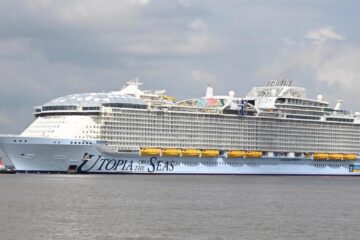It’s another week, and despite the spectacle during Tesla’s “Robotaxi” event, it brought out the worst out of the bulls and bears. Meanwhile, JPMorgan analysts are getting a kick out of the prancing horse while other analysts reevaluate Western and Chinese Tesla rivals.
Don’t miss the move: Subscribe to TheStreet’s free daily newsletter
A Tesla Optimus humanoid robot is pictured with a human
Tesla
We robot, they robot, Tesla robot
Despite starting nearly an hour late than the 7 p.m. Pacific and 10 p.m. Eastern time announced on their posts, Tesla’s (TSLA) “We, Robot” event on October 10 was a Hollywood-esque spectacle that would make Will Smith’s movie look more like a warning than a piece of entertainment.
To sum it up, Tesla CEO Elon Musk dug deeper into the statements he made during previous earnings calls about Tesla’s commitment to artificial intelligence and robotics, specifically where he said:
“I recommend anyone who doesn’t believe that Tesla would solve vehicle autonomy should not hold Tesla stock. They should sell their Tesla stock.”
Check out Tesla’s Cybercab robotaxi (TV-G; 2:07)
In front of an audience of “believers,” he unveiled the Tesla Cybercab; a low-slung, silver two-seater coupe with butterfly doors and no steering wheels or pedals. He also unveiled the “Robovan,” a locomotive-shaped autonomous vehicle with a capacity for 20 people, and the Optimus humanoid robots, which he showed off serving drinks at the bar.
Analysts are not impressed with Tesla’s AI show
Despite the lively atmosphere, the party did not translate well into the analyst’s notes the next morning, as the bears and bulls stuck to their guns.
While Bank of America Analyst John Murphy noted that the event “lived up to the hype,” other analysts were quick to point out that while those watching on the live stream and physically present at the Warner Bros. Backlot were presented with actual, physical cars and robots, the sight of them overshadowed the real issue.
In separate notes published on the morning of October 11, analysts from a mixed basket of firms and banks pointed out that Musk and Co. didn’t say much about strategy and let the shiny, new stuff speak [albeit very little] for itself.
Morgan Stanley analyst Adam Jonas said in his note that he was stunned by Tesla’s “disappointing lack of detail” during the presentation. He noted that he and others “had high expectations for Tesla to advance its AI narrative with updates on FSD improvements and a clear go-to-market strategy.” Meanwhile, Bernstein analyst Toni Sacconaghi called the demonstration “underwhelming and stunningly absent in detail.”
A Tesla Optimus humanoid robot is pictured serving humans drinks
Tesla
Over at Deutsche Bank, analyst Edison Yu said he was “underwhelmed by the lack of details,” and even Wedbush’s Dan Ives, the notorious Tesla bull, admitted that “ideally, Musk and Tesla should have spent more time on details.”
However, many netizens, as well as Deepwater Asset Management Gene Munster noted that one particular vehicle was missing from the event: the so-called Tesla Model 2, a vehicle slated to be Tesla’s “more affordable” EV.
In a post on X at 3 a.m. on October 11, Munster said “The one missing topic from tonight’s event was the ‘more affordable’ vehicle […] My sense is that the car is still on the roadmap for sometime late in 2025, but the company decided not to discuss it, as it would have triggered the Osborne Effect, causing Model 3 buyers to hold off.”
Additionally, Ives called the car’s absence the “elephant in the room,” noting that it “is also weighing on shares as the bears try to press this narrative.”
Bank of America maintains its “Buy” rating and $255 price target. Morgan Stanley reiterated its “Overweight” rating and $310 target price. Deutsche Bank maintained its “Buy” rating and set a price target of $295, while Wedbush maintained an “Outperform” rating and a $300 price target.
The lone exception is Bernsetein, which maintained its Underperform rating on Tesla shares and price target of $120.
Visitors inspect an Xpeng Inc. P7+ electric sedan at the Paris Motor Show in Paris, France
XPeng’s bet on A.I.
To many everyday Americans, the concept of artificial intelligence is still something that they are still in the dark about. But to reiterate the rapper Common in his appearance in a 2019 Microsoft commercial, the concept of A.I. allows people to “have more power at your fingertips than entire generations that came before you.”
Chinese automaker XPeng (XPEV) has been on a roll recently. In September, it introduced the MONA M03, a vehicle designed to edge the Tesla Model 3, as it is competitively priced from $16,800 to around $21,850.
On the same day Musk held his “We, Robot” event in California, XPeng officially unveiled its P7+ electric sedan in Shenzhen. It calls the vehicle the “world’s first AI car.”
Though the new four-door has a sleek, sculpted body, XPeng says the P7+ uses AI in various areas, including smart driving, power, energy control, and thermal management.
Additionally, XPeng notes that the new car has an “intelligent driving system” powered by a camera-dependent “vision-only solution” similar to Tesla’s that isn’t limited by any parameters. Its proprietary “Eagle Eye” system is powered by Nvidia Orin X chips, which powers its ability to collect information more accurately, more clearly, and from a farther distance than traditional cameras, covering an area as large as 1.8 standard football fields.
Morgan Stanley analyst Tim Hsaio wrote in a note that he believes the P7+ will be a key volume driver, especially once its price is revealed once preorders begin at the Paris Motor Show on October 14.
Morgan Stanley reiterates its overweight rating on XPeng shares and price target of $11.70.
More Business of EVs:
A ridiculous Tesla Supercharging flaw is making EV owners hostileStudy: EV charging stations have a secret built-in business benefitMercedes latest tech is ahead of Tesla in one key area
Bearish about Rivian
On October 4, Tesla rival Rivian RIVN, the California-based electric vehicle firm known for distinctive offload-oriented EV SUVs and pickup trucks, released its Q3 2024 delivery and production numbers, which reflected a significant hiccup it experienced.
In a statement, Rivian announced that it produced 13,157 units at its Normal, Illinois production facility and delivered 10,018 vehicles to customers. However, these numbers were some of its lowest quarterly figures since Q1 2023, which it attributed to recent issues at the factory.
“Rivian is experiencing a production disruption due to a shortage of a shared component on the R1 and RCV platforms. This supply shortage impact began in Q3 of this year, has become more acute in recent weeks, and continues,” the automaker said.
“As a result of the supply shortage, Rivian is revising its annual production guidance to be between 47,000 and 49,000 vehicles. The company is also reaffirming its annual delivery outlook of low single-digit growth as compared to 2023, which it expects to be in a range of 50,500 to 52,000 vehicles.”
In a recent note, Deutsche Bank analyst Edison Yu reiterated Rivian stock’s Hold rating but reduced its price target from $14 to $13 because of the admitted faults Rivian noted in its release. Yu expects these problems to linger and affect deliveries as far out as those during the first quarter of 2025.
Additionally, Yu pointed out that Rivian expected to reach a positive gross margin during Q4 2024 but doubts it is achievable. He predicts that the EV maker’s Q4 gross margin will be below breakeven.
A Ferrari Roma is displayed in the main exhibition hall at WDCC2024 in Shanghai, China
JP Morgan’s Confidence in Ferrari
Despite being one of the lowest-volume automakers in the market, Italian sports car manufacturer and racing powerhouse Ferrari (RACE) has been winning financially. According to Q2 2024 results released on August 1, adjusted EBITDA is up 13.7% year-over-year, with a net profit of 413 million Euros, or about $457 million.
But while Morgan Stanley analyst Adam Jonas credited Ferrari’s “resilient and proven business model” while dramatically raising its price target from $400 to $520 back in late August, JP Morgan Chase analysts got an inside scoop that led to their dramatic ratings and price target change.
On October 11, JP Morgan Chase analyst Ryan Brinkman raised his rating on Ferrari stock from Hold to Buy and raised his price target on the shares from $385 to $525 following a meeting between JPMorgan analysts and Ferrari’s management team.
In their note, the analyst said he left feeling confident that the prancing horse will continue to dominate in the ever-changing luxury car market, specifically in the world of EVs. While some analysts speculated that the prancing horse’s EV offerings may be a far cry from its loud, screaming gas-powered offerings, the JP Morgan analyst said they expect the EV Ferraris to be true Ferraris that deliver an authentic “Ferrari” driving experience.
According to a June report by Reuters, a Ferrari source indicated that the prancing horse’s first EV will cost in excess of $535,000 once it launches late next year.
Related: Veteran fund manager sees world of pain coming for stocks


